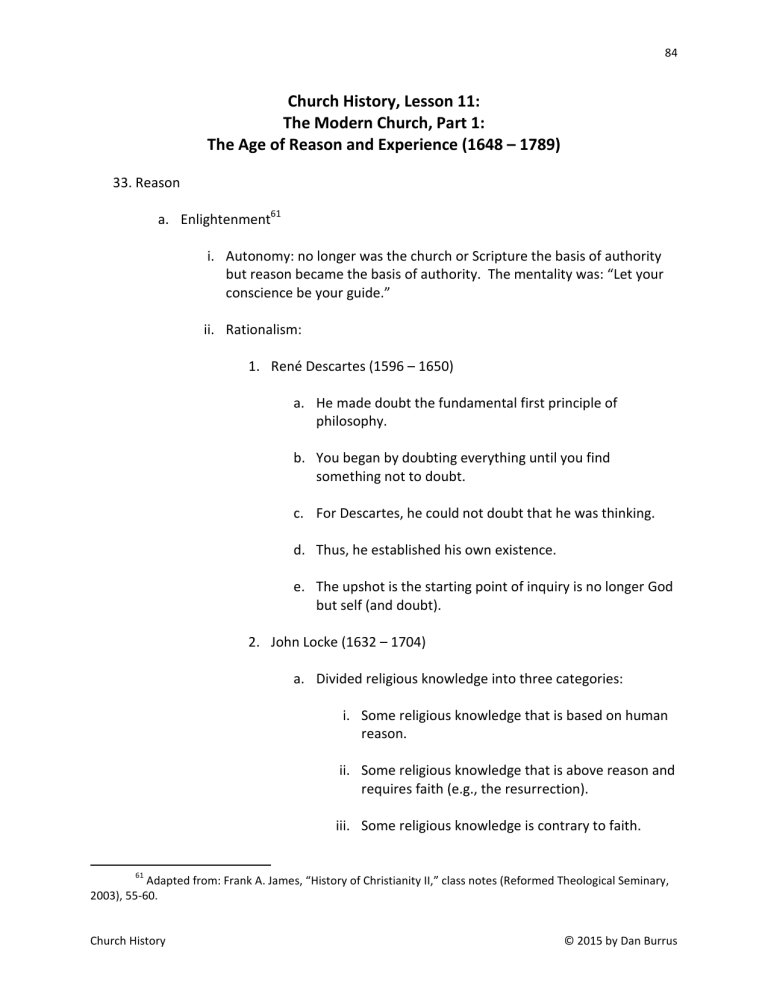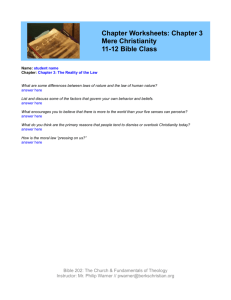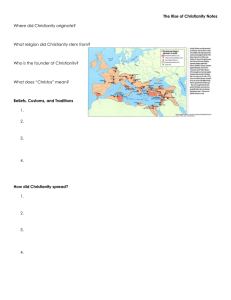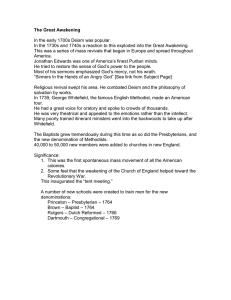
84 Church History, Lesson 11: The Modern Church, Part 1: The Age of Reason and Experience (1648 – 1789) 33. Reason a. Enlightenment61 i. Autonomy: no longer was the church or Scripture the basis of authority but reason became the basis of authority. The mentality was: “Let your conscience be your guide.” ii. Rationalism: 1. René Descartes (1596 – 1650) a. He made doubt the fundamental first principle of philosophy. b. You began by doubting everything until you find something not to doubt. c. For Descartes, he could not doubt that he was thinking. d. Thus, he established his own existence. e. The upshot is the starting point of inquiry is no longer God but self (and doubt). 2. John Locke (1632 – 1704) a. Divided religious knowledge into three categories: i. Some religious knowledge that is based on human reason. ii. Some religious knowledge that is above reason and requires faith (e.g., the resurrection). iii. Some religious knowledge is contrary to faith. 61 Adapted from: Frank A. James, “History of Christianity II,” class notes (Reformed Theological Seminary, 2003), 55-60. Church History © 2015 by Dan Burrus 85 b. The Reasonableness of Christianity (1695) suggested that ideas contrary to reason must be rejected. (Revelation cannot contradict reason.) iii. Optimism: scientific revolution 1. Nicholas Copernicus (1473 – 1543): heliocentric theory of the solar system. 2. Francis Bacon (1561 - 1626): developed the Scientific Method (empiricism). 3. Isaac Newton (1642 – 1727): three laws of motion; law of gravity. iv. Superstition 1. Enlightenment thinkers traced the persistence of superstition to Christianity. 2. To rid of superstition, Christianity must be rationalized. v. Tolerance 1. Exhausted by the religious wars, Enlightenment thinkers sought tolerance for everyone. 2. An increase in tolerance created a growing indifference to religion. 3. You can have religion, but just don’t be dogmatic about it. vi. Summary: the Enlightenment, in my opinion, ushers in the Modern Era. b. Deism (Natural religion) i. Beliefs 1. Natural laws of religion are discovered by reason. 2. God is the First Cause of creation marked by the evidence of design. 3. God left the universe to operate under natural laws. Thus, no miracles, revelation, or a God-man exist. Church History © 2015 by Dan Burrus 86 4. Jesus Christ was a moral teacher. 5. Virtue and piety are the most important characteristics of life. 6. Man is essentially good. ii. Major proponents 1. Lord Herbert of Cherbury (1583 – 1648) a. First to articulate the ideas of Deism and considered the father of Deism. b. Argued that religion is not dependent on supernatural revelation. c. Argued that people had five innate principles written on their heart: i. God exists. One does not need the Scripture to know this. ii. God must be worshiped. iii. One should practice virtue. iv. There is an obligation to repent of sins. v. There are rewards after death. 2. Matthew Tindal (1655 – 1733) a. Published Christianity As Old As Religion (1730), which is considered the Deist’s bible. The book claims: i. God must dispense his truth equally to all men at all times. ii. God must be fair according to our understanding of fairness. iii. Nothing can be admitted into Christianity except that which reason permits. Church History © 2015 by Dan Burrus 87 iv. All beliefs need to be judged as to whether or not they promote happiness. v. The purpose of creation is not to glorify God but man’s happiness. b. Asserted absolute sufficiency of natural religion. c. Christianity is to be tested by natural religion. iii. Results 1. Strengthened the omnipotence of the state because the state was seen of natural origin. 2. A rise in tolerance because Deists believe that religious ideas that were rational should be held freely. 3. The emphasis on reason led to good and bad critical study of the Scripture. 34. Experience a. Background: The Reformation Church was the birth of Protestantism and the rise of Protestant Orthodoxy or sometimes called Protestant Scholasticism. This produced, in many instances, a cold, intellectual expression of Christianity. In response to cold intellectualism, the church responded with experience. b. Pietism (Germany) i. Background: Pietism was a reaction/response (depending on how you look at it), to the “cold” orthodoxy of Lutheranism that developed in the 16th and 17th centuries. ii. Key leaders: 1. Philipp Jakob Spener (1635 – 1705) 2. Auguste Hermann Francke (1663 – 1727) 3. Count Nikolaus Ludwig von Zinzendorf (1700 – 1760) iii. Emphases Church History © 2015 by Dan Burrus 88 1. Personal Bible study over community Bible study. 2. Need for personal experience of regeneration over justification. 3. Practical holiness and good works. 4. The emotions over the intellect. 5. The individual over the institutional church. iv. Results 1. Churches: Church of the Brethren and the Moravian Church (with Zinzendorf). 2. Impact on Protestantism: Pietism made an enormous contribution not only to the German people but to Christianity worldwide. It shifted emphasis in eighteenthcentury churches from avid controversy to the care of souls. It made preaching and pastoral visitation central concerns of the Protestant ministry. It enriched Christian music enormously. And it understood the importance of a spiritual laity for a revived church.62 c. Methodism (England) i. Background: 1. England is in spiritual decline in the 17th and 18th centuries. 2. England was also experiencing rationalistic Deism. ii. John Wesley (1703 – 1791) 1. Conversion (1738): Wesley was converted 10 years after being ordained in the Church of England in 1728. Wesley writes in his journal: In the evening I went very unwillingly to a society [meeting] in Aldersgate Street, where one was reading Luther’s preface to the Epistle to the Romans. About a quarter before nine, while he was describing the change which God works in the heart through faith in Christ, I felt 62 Shelley, Church History In Plain Language, 344. Church History © 2015 by Dan Burrus 89 my heart strangely warmed. I felt that I did trust in Christ, Christ alone, for my salvation; and an assurance was given me that he had taken away my sins, even mine, and saved me from the law of sin and death.63 2. Ministry a. Organizer of the religious society known as the Holy Club. The Holy Club, originating at Oxford University, was a group of same-sex members meeting together for Bible study, encouragement, and spiritual accountability. Their strict “method” earned them the name “Methodists.” i. Rise before dawn and have devotions. ii. At night time write in a diary. iii. Fast twice a week. iv. Take communion once a week. v. Questions asked of members: 1. What known sin have you committed since our last meeting? 2. What temptations have you met with? 3. How were you delivered? 4. What have you thought, said, or done, of which you doubt whether it be sin or not?64 b. Chaplain and pastor. c. Intenerate preacher in England, Scotland, Ireland, and America. He preached over forty thousand sermons, which is an average of more than two sermons a day. 63 The Journal of the Rev. John Wesley, 8 vols. (London: Epworth, 1938), 1:475-76; quoted in: Noll, Turning Points, 225-26. 64 Quoted by Ralph W. Neighbour, Jr., in Where Do We Go From Here? A Guidebook for Cell Group Churches (Houston, TX: Touch Publications, 1990), 166-67; quoted in: C. J. Mahaney, “Why Small Groups?” in Why Small Groups?: Together Toward Maturity, ed. by C. J. Mahaney (Gaithersburg, MD: Sovereign Grace Ministries, 1996), 7. Church History © 2015 by Dan Burrus 90 Here is his account of a sermon he preached at age eighty two: Just as I began, a wasp, though unprovoked, stung me upon the lip. I was afraid it would swell, so as to hinder my speaking; but it did not. I spoke distinctly, near two hours in all; and was no worse for it.65 d. Missionary to the Indians in Georgia. 3. Doctrine a. Believed in predestination based on foreknowledge. This issue caused the split between Wesley and Whitfield. b. Believed that God by his grace restored free will to fallen humanity. c. Believed in Christian perfectionism. d. Believe a person could lose their salvation through deliberate, unrepentant sinning. 4. Legacy a. Renewed religious life in England and America. Though Wesley never broke from the Church of England, shortly after his death, his followers split from the Church of England to form the Methodists (1795). b. Social outreach to the poor. c. Stimulated missions. d. Along with his brother Charles Wesley (1707 – 1788), produced ten thousand hymns, many of which are still used to this day. i. O For a Thousand Tongues to Sing ii. And Can It Be? 65 The Journal of the Rev. John Wesley, 7:113; quoted in: Noll, Turning Points, 227. Church History © 2015 by Dan Burrus 91 iii. Hark, the Herald Angels Sing iii. George Whitfield (1714 – 1770) 1. Conversion: Converted at Oxford University at the age of 21 and joined the Holy Club. 2. Ministry a. Ordained in the Church of England in 1736 at the age of 22. b. One of the greatest preachers of all time. i. Preached in America and England. ii. Had phenomenal oratory skills. David Garrick, the 18th century actor, once said that he wished he could utter the word “Mesopotamia” as good as Whitefield uttered it!66 iii. Used passion and vivid metaphors and illustrations while preaching. It is said that you could see white gutters produced by tears running down the black faces of coal miners as they listened to Whitefield preach. iv. Preached in the “open-air” to crowds of 30,000 people, with no microphone. v. Estimated that he preached to 80% of the American colonists.67 vi. He preached over denominational barriers. Preached wherever he had a pulpit. 3. Doctrine: Calvinistic 4. Legacy: 66 67 D. Martyn Lloyd-Jones, Preaching & Preachers (Grand Rapids, MI: Zondervan, 1971), 93. James, “History of Christianity II,” 73. Church History © 2015 by Dan Burrus 92 a. Calvinistic Methodists, influencing the evangelic party in the Church of England. b. Was the impetus for the First Great Awakening in America. (Note: Many, including Whitefield, attributed the Great Awakening to Theodore J. Frelinghuysen.) iv. Results: 1. Impact on society: a. Gin traffic was stopped. b. First free medical dispensary in England in 1746. 2. Methodist Church 3. Summary: Historians readily acknowledge that Methodism ranks with the French Revolution and the Industrial Revolution as one of the great historical phenomena of the century, and some subscribe to the idea that Wesley’s preaching saved England from a revolution similar to that of France.68 d. First Great Awakening (America) i. Background: 1. A general spiritual apathy and religious nominalism. Jonathan Edwards spoke of an “extraordinary dullness in religion.” 2. Half-Way Covenant (1662): baptism of children whose parents don’t profess belief in Christianity with the hope of keeping the next generation in the church. ii. Jonathan Edwards (1703 – 1758) 1. Ministry a. Pastor in Northampton, MA. 68 Cairns, Christianity Through The Centuries, 384. Church History © 2015 by Dan Burrus 93 b. Writer and Theologian i. A Treatise on Religious Affections (1746) ii. The Freedom of the Will (1754) c. Missionary to the Indians d. President of Princeton 2. Legacy a. Edwards is considered by secular and religious scholars to be one of the most brilliant minds America has ever produced. b. Edward’s writings and sermons have left a lasting impact on the Church and culture (e.g., “Sinners in the Hands of an Angry God” [1741]). iii. Results of the First Great Awakening 1. Conversion and an increase to church membership rolls. 2. A higher moral tone in society. 3. Colleges formed: Princeton (College of New Jersey), Dartmouth, and Brown. 4. Missionary work spurred on (e.g., David Brainerd among the Indians). And the publication of Brainerd’s diary by Edwards inspired many to be missionaries. 5. Two groups emerged in the wake of revival: a. Old Lights/Old Side led by Charles Chauncy who opposed revival, itinerant evangelists. b. New Lights/New Side led by Jonathan Edwards who supported revival. Church History © 2015 by Dan Burrus



